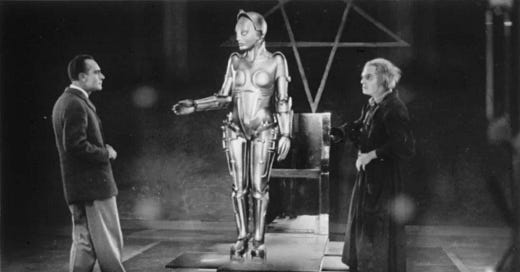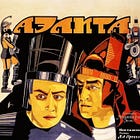A City Dystopia: Metropolis
Experience Fritz Lang's 1927 masterpiece, Metropolis, a compelling cinematic exploration of societal conflicts and class contradictions in the aftermath of World War I
Metropolis, directed by Fritz Lang in 1927, stands as one of the most compelling films that vividly portrays the contradictions and conflicts among societal classes striving to survive in the aftermath of the Great War (World War I). It was created during the Weimar Republic (1919-1933), a period when the Social Democratic Party of Germany led the labor movement but lacked the power to quell social tensions. This republican era, coinciding with a turbulent economic period, brought forth unquenchable fears across various societal strata, alienation, demands for efficiency and productivity, and most crucially, disruptive urban dynamics. It was during such a tumultuous period that Fritz Lang's "Metropolis" was born. Giovanni Scognamillo, one of the greatest writers and critics in Turkish cinema history, made one of the most accurate observations about the film, stating, "Metropolis is built upon a deep-seated need for resentment, reckoning, and judgment, reflecting a profound hostility towards the defense and preservation of noble urban ideals and the collapse of state authority."
Cinema, born alongside urban modernity, would come to life in Germany with the film company UFA (Universum Film AG). UFA was to create films that celebrated national heroism and spirit, introduced German national characteristics to foreigners, and elevated the aesthetic standards of German cinema, essentially creating Expressionism as a reflection of German idealism. The emergence of this art movement was the result of the fusion of artistic quests with political and economic crises.
While it is highly likely that Fritz Lang conceived the idea of creating the film "Metropolis" after his first view of New York, the director also had the opportunity to observe the destructive impact of the modern city, especially in the context of the Big Apple's path toward the Great Depression, which subsequently earned New York the nickname "Big Apple" starting in the 1920s.
If we are to share some of the facts presented in "Metropolis," foremost among them would be the contradictions between the real world and an individual's inner world. The film narrates class tensions that manifest in the intense industrialization and urbanization of the era, depicted through a fictional urban backdrop. Additionally, it delves into the growing proletarian consciousness in Germany during the 1920s, the increasing anxiety of the bourgeois class regarding the future, and the narrative's significance. The correct and effective use of the "Schüfftan Method," named after one of the most famous cinematographers of the era, Eugene Schüfftan, is also a significant milestone in the film, bringing it into the spotlight within the science fiction genre. The Schüfftan Method can be regarded as a contemporary of an illusion technique used in the 19th century called "Pepper's Ghost," which involved mirrors and light effects. In the years to come, this method would reappear in films by directors such as Alfred Hitchcock's "Blackmail" (1929), "The 39 Steps" (1935), and Peter Jackson's "The Lord of the Rings: The Return of the King" in 2003. "Metropolis" is considered one of the top ten science fiction films of all time as of our current era.
In this section where we will delve into the film's plot, it's worth noting that "Metropolis" holds much greater significance compared to other films of its time, and that's why it will have a more prominent place in our pages. The inspiration for the film is the capital of the Weimar Republic, Berlin, which is presented as the epicenter of a dystopian and futuristic life. "Metropolis" was produced with a colossal budget of around two hundred million dollars according to 2005 data, boasting a runtime of two hours and thirty-three minutes with changing music and scenes, making it a true visual spectacle. Part of the original 153-minute version of the film has been lost, but 118 minutes were restored in 2002, and with further corrections in 2010, the film was reconstructed to 148 minutes. The film, adapted to cinema from the book of the same name by Fritz Lang's wife, Thea von Harbou, constitutes a powerful rebellion against capitalism and the worldwide trend of growing mechanization.
In the film, one remarkable starting point is the zombie-like movements of the workers, divided into groups of six. They walk in an orderly and exhausted manner. As expressed in the novel: "Their march is not walking; it's merely the act of moving one foot in front of the other." In other words, there's instinct rather than consciousness at play in their actions. While the movements of the workers, who go to and return from their shifts, can be likened to the classic operation of a machine, scenes that depict the privilege enjoyed by the upper class, when contrasted with the bleak and modest lives of the workers living underground, strongly allude to the profound chasm that continues to exist between different classes today. The soulless, humble, and confined life of the workers below ground, dressed in black attire and reduced to mechanical behaviors, is juxtaposed with the open white skies, carefree lives, and freedom of movement enjoyed by those above ground. Examining the architectural aspect of the film, we see that Metropolis is designed as a futuristic city far beyond its time. The headquarters of Joh Fredersen, who governs Metropolis, draws inspiration from Pieter Brueghel's 1563 painting "The Tower of Babel."
The plot of the film, where class conflict is narrated at every turn, begins with the carefree life of Freder (Gustav Fröhlich), the son of Joh Fredersen (Alfred Abel), the creator and wealthiest dictator of Metropolis, along with other rich kids from the upper society. Freder's happiness is disrupted when Maria (Brigitte Helm) appears as the sacred virgin figure. Freder's path intersects with this beautiful woman when Maria, an advocate for workers' rights, brings some working-class children to see the privileged lives of the wealthy. Freder will rid himself of his dream and head to the underground machine city in search of Maria. The primitive life of the workers, which leaves one in astonishment, and the workers' death in a massive explosion at the city's largest factory deeply affect the young man. When Freder goes to his father to tell him about what he has witnessed and doesn't receive the expected reaction, he decides to take matters into his own hands. Foreman Grot (Heinrich George) finds maps on the deceased workers and brings them to Frederson. As his son's unusual behaviors catch his attention, the father assigns a spy to follow him.
During this time, Freder will receive news of a secret meeting led by Maria using the same map he found in the pocket of a worker who fainted on duty and will change his clothes. Joh, who goes to the mad scientist Rotwang (Rudolf Klein-Rogge) to learn the map's codes, is unaware of the mad professor's secret agenda. While Rotwang is a stock character in popular cinema, we can trace the origins of mad scientists back to Mary Shelley's Victor Frankenstein and Goethe's Faust. Rotwang may well be the cinematic embodiment of these protagonists. His appearance would reemerge in Stanley Kubrick's 1964 film, where Peter Sellers would play the character of Dr. Strangelove.
Returning to Rotwang in the film, only Fredersen knows the extent of his genius. On the other hand, a character is introduced to us: "Hel." This character (or rather a character introduced with a mythological bust) is the equivalent of Hades in Finnish mythology, the goddess of death. Hel is a death machine designed by Rotwang. As we will see at the end of the film, it will be burned in a ceremony dating back to the Middle Ages.
Rotwang was abandoned by the woman he loved, Hel, who married Joh Fredersen. His hatred for Joh intensifies because of Hel's death during Freder's birth. Rotwang will bide his time to take revenge, continuing to collaborate with Joh until the right moment comes. This is because he holds Freder responsible for Hel's death. If not for the birth, Hel wouldn't have died.
During this time, Maria will predict a future revolution to the workers she has gathered in the underground catacombs. She believes that this revolution will unite the worker and manager classes. Freder will believe that he is the one destined to lead this revolution and will declare his love to Maria. But there's something the two lovers don't know: that is, Maria's meeting has been secretly eavesdropped on by his father and Rotwang. Here, the idea of a mediator, religious services in the underground catacombs, and the sacred mother of humanity, Mary (Maria), are intertwined with Christian propaganda. This leads Lang to compress the theme of class exploitation, which was prevalent in the first part of the film, into a focus on love and religion. In other words, capitalism is becoming more humane.
Maria and Freder will plan to meet at the cathedral the next day, but Joh tells Rotwang to create a machine-woman (Maschinenmensch) that is an exact copy of Maria. This way, Maria's reputation will be tarnished in the eyes of the workers, and Joh will regain his former power. One can speculate that Freder's father wants to eliminate Maria, the woman his son loves. In fact, an Oedipal conflict is at play here; according to the Oedipus complex, the son sees his father, Fredersen, as a rival.
Rotwang kidnaps his daughter and initiates the transformation. Meanwhile, Freder, hearing the girl's screams, cannot reach her because of the trap set by Rotwang, and he can't reach her until the transformation is complete. Robot-Maria is a complete nuisance; she has brought chaos and anarchy to the city, convinced the workers to destroy the heart machine that runs Metropolis, and instigated looting in many parts of the city, causing complete disorder. Due to their obsession with her, many men in the city start rioting, and the city's functioning is entirely disrupted as the water pumps stop working, leading to the underground city being submerged in water.
The anger of the workers, who believe they have lost their children, is directed at Robot-Maria, and the workers, led by Grot, will burn the machine-woman at a massive barricade in front of the cathedral. After burning, the robot turns back into a human, which shocks the crowd. The film's ending will be marked by an agreement between Maria (Mary), Freder (the City's Dictator), Frederson (the Mediator), and Grot (the City's Deputy Prosecutor and Leader of the Workers) and the restoration of order in Metropolis.
As seen above, the film essentially starts as an expressionist piece but ends in a more moderate tone. The recurring phrase "the mediator between the head (the planners) and the hands (the workers) must be the heart" demonstrates how closely it appears to align with the corporatism that fascism built on its economy at that time. Joseph Goebbels, who was watching the film, will offer Fritz Lang to become the official filmmaker of Nazism. Hitler will also appreciate the film and will say that the film serves National Socialism and contains fascist propositions. The film was first shown in Germany on January 10, 1927, but it was banned on the verge of being released in Istanbul in October 1927, with the pretext that it promoted atheism and praised communism.








